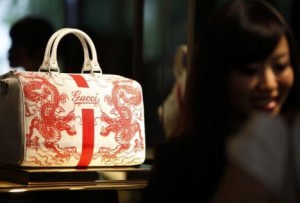The Luxury Pickle
As designer brands move to the East to make money, Asian shoppers fly to the West to spend money.
By: Ellie Chan, Staff Writer
 Luxury brand flagship stores in Paris like Louis Vuitton and Longchamp along the infamous Champs-Élysées rolled out sale promotions and slashed their prices. They were in preparation for China’s Golden Week, a national one-week holiday that often results in shopping sprees, vacation spending and a surge of retail sales. As CNTV reported, in 2010, China’s retail sales alone exceeded 590 billion yuan in the 7-day period of the October Golden Week. French retail, no doubt, wanted a piece of that pie.
Luxury brand flagship stores in Paris like Louis Vuitton and Longchamp along the infamous Champs-Élysées rolled out sale promotions and slashed their prices. They were in preparation for China’s Golden Week, a national one-week holiday that often results in shopping sprees, vacation spending and a surge of retail sales. As CNTV reported, in 2010, China’s retail sales alone exceeded 590 billion yuan in the 7-day period of the October Golden Week. French retail, no doubt, wanted a piece of that pie.
Yet, if you strolled down the Champs-Élysées, you might have find yourself stopped by an Asian tourist ready to give you cold cash if you helped them purchase designer goods from the boutiques. Many brand names including Gucci, Hermès, and Louis Vuitton, restrict Asian shoppers from purchasing more than 2 items per day. Those who want to buy more idle along the Champs-Élysées, soliciting passers-by, euro bills prominent in their hand.
The two scenarios in Paris seem to be contradictory: the first encourages consumer spending and the second controls purchases, yet they perfectly illustrates the designer houses’ dilemma.
[pullquote][Mainland China shoppers] would prefer flying to France, Italy, or even Hong Kong, to make their purchases, and resell them in China to reap a profit (lucrative enough to cover traveling costs!)[/pullquote]
It is a fact that luxury giants like the PPR Group (which owns Gucci and Puma) and the LVMH Group (which owns Louis Vuitton and Moët Hennessy) are focused on pocketing Asian dollars and have been aggressively expanding in the East. Prada’s recent IPO in Hong Kong proves the European appetite for Asian spending power. However, China also has the highest luxury goods taxes in the world. Topped with sky-high rents in premium shopping malls, designer goods are actually cheaper outside the mainland. Local shoppers would prefer flying to France, Italy, or even Hong Kong, to make their purchases, and resell them in China to reap a profit (lucrative enough to cover traveling costs!). The luxury goods makers cannot let consumers benefit from a pure pricing arbitrage , and they limit purchases – a policy that seems to target only Asian customers.
With the luxury brands already heavily invested in China with high-end boutiques, the challenge is to convince Chinese shoppers to stay at home and buy at a higher price. Miu Miu, a design house owned by Prada, might have found the answer. This past February, Miu Miu launched an exclusive collection of red handbags (only 50) to celebrate the Chinese New Year. These bags were only available in the design house’s Hangzhou store. This strategy seems like a clever attempt to get shoppers into the local store, and creates a sense of exclusivity and prestige to justify high prices.
The luxury goods landscape will continue to change dramatically. As recently reported in the Financial Times, the Chinese government is considering a tax cut on import luxury goods by 2-15% as part of an economic plan to encourage local consumption. This could happen as early as this October, and could very well get the high fashion houses out of their pickle. Luxury consumption is likely, then, to shift from Europe and Hong Kong back to China and feed the fastest growing market in the world. This is the exact good news the designer brands are hoping for, because if you think the Chinese are buying now, just wait.
ARB Team
Arbitrage Magazine
Business News with BITE.
Liked this post? Why not buy the ARB team a beer? Just click an ad or donate below (thank you!)
Liked this article? Hated it? Comment below and share your opinions with other ARB readers!





























Share the post "The Luxury Pickle"